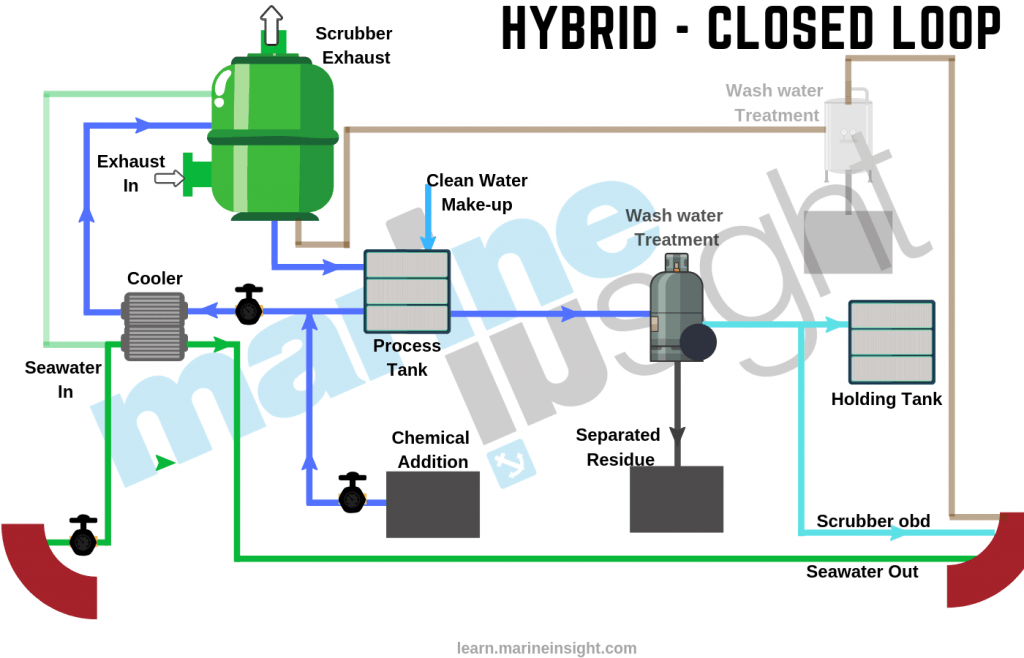Under regulation 4 of MARPOL Annex VI the exhaust gas cleaning systems (scrubber) are excepted based on the criteria described on the guideline (resolution MEPC 259(68)). Wash water parameters limit was set for PH, PAH, Turbidity and Suspended particle maters and Nitrate.
To fulfil the specific requirements of the regulations three types of scrubber are being used which are generally designed to retrofit.
- Open Loop
- Closed Loop
- Hybrid
General maintenance of the scrubber is usually same for all three types. Some additional maintenance for close loop and hybrid system is there.
Fig: Typical view of a scrubber
Main parts of the scrubber are
- Seawater pumps (VFD operated)
- Auto back flushing and bypass filters
- Seawater analyzing unit
- Seawater flowmeters
- Seawater nozzles.
- Exhaust extractor fan.
- Exhaust gas analyzing unit
- Wash water analyzing unit
- Neutralizing agent dosing unit.
Seawater pumps (VFD operated)
Seawater pumps are generally VFD (Variable frequency drive) operated to give a constant flow during a load change. Pumps are designed to provide high flow to wash exhaust gas perfectly. General maintenance like seawater pumps needs to do. The attached seawater strainer needs to clean periodically. MGPS system for dedicated sea chest needs to maintain properly.
Auto back flushing and bypass filters
After the pump, seawater passes through an Auto backwashing filter to protect scrubber nozzles from being chocked. When the differential pressure of the filter increases it automatically back flushes without hampering the scrubber operation. Periodically need to clean the filter and back flushing motor can be overloaded due to dirt clogging inside the filter.
Fig: Back Wash Filter
Sea water analyzing unit
After filter Sea water analyzing unit analyzes for pH, Turbidity and measure the seawater temperature. Sensors for pH and Turbidity are calibrated by shore technicians. Ship’s crew needs to validate the sensors usually in three months period.
Scrubber unit
Inside the scrubber Seawater sprays by specially designed nozzles to properly mix with exhaust gas. Exhaust gas from all the machineries come to a common manifold. In the manifold, there are to dampers, one for direct emission to atmosphere another damper opens to the scrubber. Seawater nozzles are placed in different places for proper wash out of the gas. Nozzles can be chocked by foreign particles. During inspection need to clean the nozzles if found choked.
The scrubber is an enclosed space. Enclosed space entry procedure to be followed before entering into the scrubber for maintenance.
A bypass damper is fitted in one of the generator exhaust lines which will allow running the generator in case of any emergency.
Fig: View of sea water spraying nozzle
Exhaust extractor fan.
There is a VFD operated exhaust extractor fan that is placed on top of the scrubber to create a cyclone for better washing of gas and also pushing the exhaust gas to the atmosphere. Carefully need to keep eye on fan sealing as the seawater from inside can damage the windings of the fan motor. Motor bearings need to greased with special types of H.T grease.
Exhaust gas analyzing unit
Before released to the atmosphere Exhaust gas analyzing unit continuously monitor the gas for SO2, CO2, Sulphur and SO2/ CO2 ratio. If the Sulphur content increases the unit gives a signal to neutralizing agent injector pump regulator to inject alkaline chemicals to reduce the Sulphur content in the gas. Sensors are calibrated by shore technicians. Ship’s crew needs to validate the sensors usually in three months period.
Fig: View of a scrubber control monitor
Wash water analyzing unit
Wash water analyzing unit analyzes the water for pH, PAH, Turbidity and Suspended particle maters and Nitrate. A small vane sampling pump takes the wash water samples and passes it to the sensors. If the measured values cross the preset value it raises alarm. If the measured pH of the wash water lower than 3.5 it gives the signal to neutralizing agent dosing pump regulator to inject alkaline chemicals to increase the pH value of the discharged water. Sensors are calibrated by shore technicians. Ship’s crew needs to validate the sensors generally in three months period.
Neutralizing agents
Few neutralizing agents can improve the performance of the system. The commonly known agents are caustic soda (NaOH) or sodium carbonate (Na2co3) or magnesium oxide (MgO). These are generally received from the supplier in liquid form.
Maintaining the chemicals improper state is very important. The chemicals are very temperature sensitive. It may be very catastrophic if the chemical temperature is not maintained within the prescribed temperature range. Proper chemical handling equipment’s to be used and PPE to be worn before handling the chemical.
Additional maintenance for closed-loop and hybrid system is there. Exhaust sludge residue tank and wash water collecting tanks need to maintain in proper condition. Exhaust sludge residue to be discharged to the shore facilities.
Scrubber log record
There is an official dedicated log record book for scrubber run-time parameters. Parameters to be recorded daily. All the scrubber related information also needs to be recorded such as neutralizing agent bunkering, non-compliance, incident related to the scrubber, sensors calibration reports, etc.
End of the day scrubber is a whole new type of machinery introduced in the marine industry. Ultimate care of this should be taken. Maintenance of this needs to be done carefully. Failing of the equipment/ lack of maintenance can end up in a huge financial loss for the owners.
References
- Resolution MEPC.259(68)- 2015 Guidelines For Exhaust Gas Cleaning Systems- IMO
- Technical Update 13-2014 / November – Preparing For Low Sulphur Operation-DNVGL
- Prevention Of Pollution Of The Sea (Air) Regulations- MPA
- Operation and maintenance manual CM.
- imo.org
